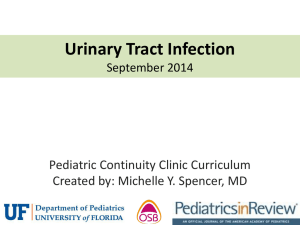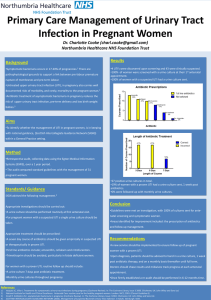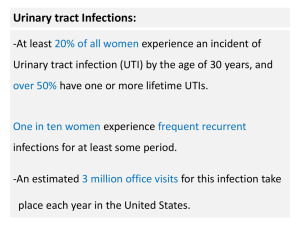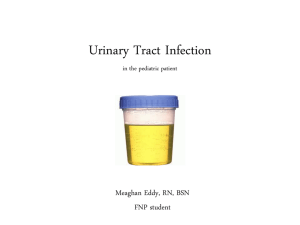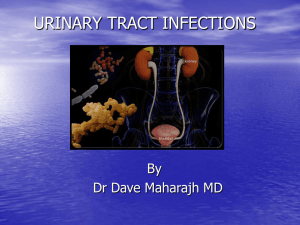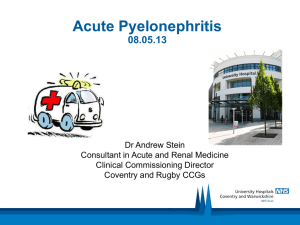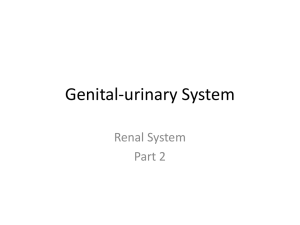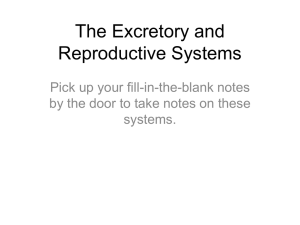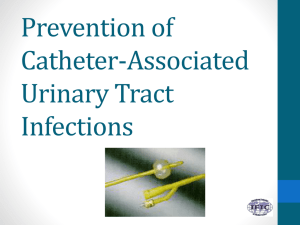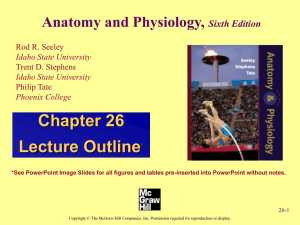Slide 1
advertisement
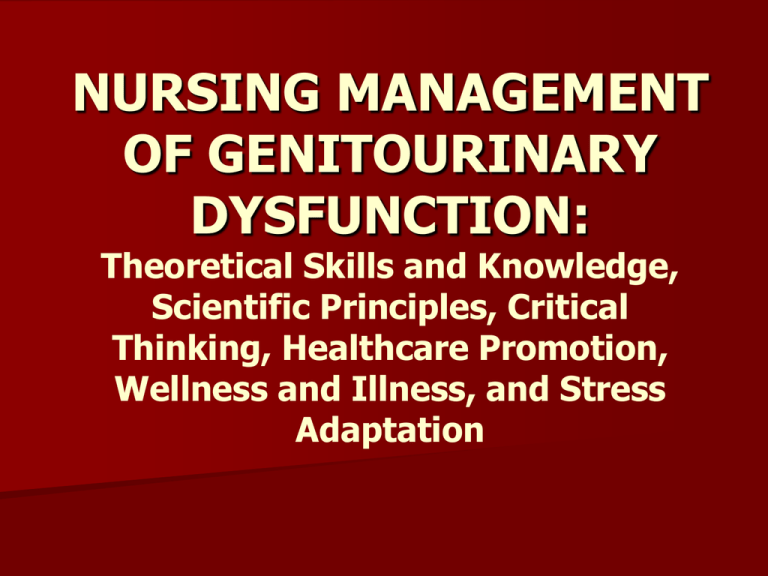
NURSING MANAGEMENT OF GENITOURINARY DYSFUNCTION: Theoretical Skills and Knowledge, Scientific Principles, Critical Thinking, Healthcare Promotion, Wellness and Illness, and Stress Adaptation Lecture Objectives: 1. 2. 3. 4. 5. Describe common renal and urinary disorders that occur in children. Assess a child for a renal or urinary tract disorder. Formulate nursing diagnoses related to renal or urinary tract disorders. Establish outcomes related to the care of a child with renal or urinary disorder. Plan nursing care related to urinary or renal disorders. Lecture Objectives (cont.) 6. 7. 8. 9. 10. 11. Implement nursing care for the child with a renal or urinary disorder. Evaluate outcomes for achievment and effectiveness of care. Analyze methods for making nursing care of the child with a renal or urinary disorder more family centered. Compare and contrast acute and chronic renal failure. Discuss the types of renal dialysis. Assess for signs of kidney transplant rejection. Reading Assignment: Wong, Perry & Hockenberry Ch. 50; p 1643-1669 Renal System Assessment Physical assessment – Palpation, percussion Health history – Previous UTIs, calculi, stasis, retention, pregnancy, STDs, bladder cancer – Meds: antibiotics, anticholinergics, antispasmodics – Urologic instrumentation – Urinary hygiene – Patterns of elimination Nursing Assessment of Urinary Tract Infection (UTI) Nausea, vomiting, anorexia, chills, nocturia, frequency, urgency Suprapubic or lower back pain, bladder spasms, dysuria, burning on urination Nursing Assessment of Urinary Tract Infection (UTI) Objective data – Fever – Hematuria, foul-smelling urine; tender, enlarged kidney – Leukocytosis, positive findings for bacteria, WBCs, RBCs, pyuria, ultrasound, CT scan, IVP Diagnostic Studies Renal scan Cystogram Retrograde pyelogram Ultrasound CT MRI Renal arteriogram UA Urine C&S BUN Creatinine KUB IVP VCG/VCUG Normal Urinalysis pH: 5 to 9 Sp gr: 1.001 to 1.035 Protein: <20 mg/dl Urobilinogen: up to 1 mg/dl None of the following: – Glucose – Ketones – Hgb – WBCs – RBCs – Casts – Nitrite Normal Characteristics of Urine Color range Clear Newborn production—approx 1-2 ml/kg/hr Child production—approx 1 ml/kg/hr Urinary Tract Infection (UTI) Is it really that serious? Concept of “asymptomatic bacteria” in urinary tract Urinary Tract Infection (UTI) Causes Escherichia coli most common pathogen Streptococci Staphylococcus saprophyticus Occasionally fungal and parasitic pathogens Classification of UTI Upper tract: involves renal parenchyma, pelvis, and ureters – Typically causes fever, chills, flank pain Lower tract: involves lower urinary tract – Usually no systemic manifestations Classification of UTI Lower tract Cystitis Urethritis Glomerulonephritis Upper tract Pyelonephritis VUR Classification of UTI Uncomplicated infection Complicated infections – Stones – Obstruction – Catheters – Diabetes or neurologic disease – Recurrent infections Types of UTIs Recurrent—repeated episodes Persistent—bacteriuria despite antibiotics Febrile—typically indicates pyelonephritis Urosepsis—bacterial illness; urinary pathogens in blood Etiology and Pathophysiology of UTI Physiologic and mechanical defense mechanisms maintain sterility – Emptying bladder – Normal antibacterial properties of urine and tract – Ureterovesical junction competence – Peristaltic activity Etiology and Pathophysiology of UTI Alteration of defense mechanisms increases risk of UTI Organisms usually introduced via ascending route from urethra Less common routes – Bloodstream – Lymphatic system Etiology and Pathophysiology of UTI Contributing factor: urologic instrumentation – Allows bacteria present in opening of urethra to enter urethra or bladder Sexual intercourse promotes “milking” of bacteria from perineum and vagina – May cause minor urethral trauma Etiology and Pathophysiology of UTI UTIs rarely result from hematogenous route For kidney infection to occur from hematogenous transmission, must have prior injury to urinary tract – Obstruction of ureter – Damage from stones – Renal scars Etiology and Pathophysiology of UTI UTI is a common nosocomial infection – Often E. coli – Seldom Pseudomonas Urologic instrumentation common predisposing factor Clinical Manifestations of UTI Symptoms – Dysuria – Frequent urination (>q2h) – Urgency – Suprapubic discomfort or pressure Clinical Manifestations of UTI Urine may contain visible blood or sediment (cloudy appearance) Flank pain, chills, and fever indicate infection of upper tract (pyelonephritis) Pediatric Manifestations Frequency Fever in some cases Odiferous urine Blood or blood-tinged urine Sometimes NO symptoms except generalized sepsis Pediatric Manifestations Pediatric patients with significant bacteriuria may have no symptoms or nonspecific symptoms like fatigue or anorexia So how do you find out? Diagnostic Studies of UTI Dipstick Microscopic urinalysis Culture Diagnostic Studies of UTI Clean-catch is preferred U-bag for collection from child Specimen obtained by catheterization or suprapubic needle aspiration has more accurate results – May be necessary when clean-catch cannot be obtained Diagnostic Studies of UTI Sensitivity testing determines susceptibility to antibiotics Imaging studies for suspected obstruction – IVP or Abd CT Collaborative Care for UTI Drug Therapy: Antibiotics Uncomplicated cystitis: shortterm course of antibiotics Complicated UTIs: long-term treatment Collaborative Care for UTI Drug Therapy: Antibiotics Trimethoprim-sulfamethoxazole (TMPSMX) or nitrofurantoin Amoxicillin Cephalexin Others – Gentamycin, carbenicillin ++ Pyridium (OTC) Combination agents (e.g., Urised) used to relieve pain – Preparations with methylene blue tint Collaborative Care for UTI Drug Therapy For repeated UTIs – Prophylactic or suppressive antibiotics – TMP-SMX administered daily to prevent recurrence or single dose before events likely to cause UTI Etiology and Pathophysiology of Acute Pyelonephritis Inflammation caused by bacteria, fungi, protozoa, or viruses infecting kidneys Urosepsis: systemic infection from urologic source – Can lead to septic shock and death in 15% of cases Etiology and Pathophysiology of Acute Pyelonephritis Usually infection is via ascending urethral route Frequent causes – E. coli – Proteus – Klebsiella – Enterobacter Etiology and Pathophysiology of Acute Pyelonephritis Commonly starts in renal medulla and spreads to adjacent cortex Recurring episodes lead to scarred, poorly functioning kidney and chronic pyelonephritis Clinical Manifestations of Acute Pyelonephritis Vary from mild to “classic” and very severe Presenting symptoms – N/V, anorexia, chills, nocturia, frequency, urgency – Suprapubic or low back pain, dysuria – Fever, hematuria, foul-smelling urine Costovertebral tenderness Symptoms often subside in a few days, even without therapy – Bacteriuria and pyuria still persist Diagnostic Studies of Acute Pyelonephritis Urinalysis WBC casts CBC Imaging studies (IVP or CT) Ultrasound Collaborative Care of Acute Pyelonephritis Hospitalization Parenteral antibiotics Collaborative Care of Acute Pyelonephritis Relapses treated with 6-week course of antibiotics Reinfections treated as individual episodes or managed with long-term therapy – Prophylaxis may be used for recurrent infections Types of Glomerulonephritis Most are postinfectious – Pneumococcal, streptococcal, or viral May be distinct entity or May be a manifestation of systemic disorder – SLE – Sickle cell disease – Others Glomerulonephritis Symptoms Generalized edema due to decreased glomerular filtration – Begins with periorbital – Progresses to lower extremities and then to ascites HTN due to increased ECF Oliguria Glomerulonephritis Symptoms Hematuria – Bleeding in upper urinary tract→smoky urine Proteinuria – Increased amount of protein = increased severity of renal disease Acute Post-Streptococcal Glomerulonephritis Is a noninfectious renal disease – Autoimmune Onset 5 to 12 days after other type of infection Often group A ß-hemolytic streptococci Most common in 6 to 7 years old Uncommon in <2 years old Can occur at any age Diagnosing APSG Prognosis 95%—rapid improvement to complete recovery 5% to 15%—chronic glomerulonephritis 1%—irreversible damage Nursing Management of APSG Manage edema – Daily weights – Accurate I&O – Daily abdominal girth Nutrition – Low sodium, low to moderate protein Susceptibility to infections Bed rest is not necessary Nephrotic Syndrome Most common presentation of glomerular injury in children Characteristics – Proteinuria – Hypoalbuminemia – Hyperlipidemia – Edema – Massive urinary protein loss Types of Nephrotic Syndrome Minimal change nephrotic syndrome (MCNS) – AKA Idiopathic nephrosis Nil disease Uncomplicated nephrosis Childhood nephrosis Minimal lesion nephrosis Congenital nephrotic syndrome Secondary nephrotic syndrome Changes in Nephrotic Syndrome Glomerular membrane – Normally impermeable to large proteins – Becomes permeable to proteins, especially albumin – Albumin lost in urine (hyperalbuminuria) – Serum albumin decreased (hypoalbuminemia) – Fluid shifts from plasma to interstitial spaces Hypovolemia Ascites Nephrotic Syndrome Management Supportive care Diet Steroids – Low to moderate protein – Sodium restrictions when large amount edema present – 2 mg/kg divided into BID doses – Prednisone drug of choice ($$ and safest) Immunosuppressant therapy (Cytoxan) Diuretics Family Issues Chronic condition with relapses Developmental milestones Social isolation – Lack of energy – Immunosuppression/protection – Change in appearance due to edema – Self-image Nursing Interventions Aseptic technique during catheterizations Avoid unnecessary catheterization and early removal of indwelling catheters Prevents nosocomial infections – Wash hands before and after contact – Wear gloves for care of urinary system Nursing Interventions Routine and thorough perineal care for all hospitalized patients Avoid incontinent episodes by answering call light and offering bedpan at frequent intervals Nursing Interventions Ensure adequate fluid intake (patient with urinary problems may think will be more uncomfortable) – Dilutes urine, making bladder less irritable – Flushes out bacteria before they can colonize – Avoid caffeine, alcohol, citrus juices, chocolate, and highly spiced foods Potential bladder irritants Nursing Interventions Discharge to home instructions Follow-up urine culture Recurrent symptoms typically occur in 1 to 2 weeks after therapy – Encourage adequate fluids even after infection – Low-dose, long-term antibiotics to prevent relapses or reinfections – Explain rationale to enhance compliance Hemolytic-Uremic Syndrome Pathophysiology Diagnostic evaluation Therapeutic management Prognosis Nursing consideration Wilms’ Tumor Etiology Diagnostic evaluation Therapeutic management – Surgical removal – Chemotherapy and/or radiation Nursing considerations Renal Failure Acute renal failure (ARF) Chronic renal failure (CRF) Acute Renal Failure (ARF) Definition: kidneys suddenly unable to regulate volume and composition of urine Not common in children Principal feature is oliguria – Associated with azotemia, metabolic acidosis, and electrolyte disturbances Most common pathologic cause: transient renal failure resulting from severe dehydration Acute Renal Failure (ARF) Pathophysiology—usually reversible Diagnostic evaluation Therapeutic management Nursing considerations Complications of ARF Hyperkalemia Hypertension Anemia Seizures Hypervolemia Cardiac failure with pulmonary edema Chronic Renal Failure (CRF) Begins when diseased kidneys cannot maintain normal chemical structure of body fluids Clinical syndrome called uremia Potential Causes of CRF Congenital renal and urinary tract malformations VUR associated with recurrent UTIs Chronic pyelonephritis Chronic glomerulonephritis CRF (cont’d) Pathophysiology Diagnostic evaluation Therapeutic management – Manage diet, hypertension, recurrent infections, seizures Nursing considerations Dialysis Peritoneal dialysis Hemodialysis Hemofiltration Peritoneal Dialysis The preferred method of dialysis for children Abdominal cavity acts as semipermeable membrane for filtration Can be managed at home in some cases Warmed solution enters peritoneal cavity by gravity, remains for period of time before removal Hemodialysis Requires creation of a vascular access and special dialysis equipment Best suited for children who can be brought to facility 3 times/week for 4 to 6 hours Achieves rapid correction of fluid and electrolyte abnormalities Transplantation From living related donor From cadaver donor Primary goal is LT survival of grafted tissue Role of immunosuppressant therapy
